In today's fast-paced business environment, hiring a Chief Information Officer (CIO) is critical for companies looking to leverage technology for strategic advantage. A CIO not only oversees the IT department but also plays a crucial role in shaping the organization’s digital transformation strategy. However, many companies struggle to find a candidate who aligns with their business vision and has the right mix of strategic insight and technical expertise.
This article explores the multifaceted role of the CIO, outlining the skills and qualifications needed for the position. We’ll guide you through the hiring process, from crafting a compelling job description to evaluating candidates using skills tests and case study assignments. For more resources on crafting job descriptions, visit our CIO job description page.
Table of contents
What Does a Chief Information Officer Do?
A Chief Information Officer (CIO) is responsible for overseeing and directing the information technology (IT) strategy of an organization. They align technology initiatives with business goals, manage IT resources, and ensure the company's digital assets are secure and efficient.
The day-to-day responsibilities of a CIO include:
- Developing and implementing IT policies and best practices
- Managing IT budgets and staff
- Evaluating and adopting new technologies
- Ensuring data security and compliance
- Collaborating with other executives to drive digital transformation
- Overseeing major IT projects and system implementations
- Analyzing the costs and benefits of IT investments
Chief Information Officer Hiring Process
Hiring a Chief Information Officer (CIO) is a strategic decision that impacts the technological direction of your organization. The process typically spans 1-2 months, balancing between finding the right fit and moving efficiently.
- Craft a precise job description that captures the responsibilities and expectations of the CIO role. Post it on relevant job boards to attract qualified candidates.
- Resume screening happens next. Aim for a shortlist within the first week by focusing on candidates with experience in IT leadership and digital transformation.
- Skill assessments should be tailored to the CIO role, focusing on leadership, strategic thinking, and technical expertise. This may include case studies or role-specific tests.
- Interviews are crucial for evaluating cultural fit and strategic alignment. Plan for multiple rounds involving executive leadership to ensure all perspectives are considered.
- Offer and negotiation should be initiated once the top candidate is identified. Be prepared to discuss compensation packages and growth opportunities.
Overall, the CIO hiring process demands careful planning and execution. Keep stakeholders informed and align the process with organizational goals. Now, let's dive deeper into each step to ensure a successful hire.
Key skills and qualifications for a Chief Information Officer
Crafting the ideal candidate profile for a Chief Information Officer (CIO) can be tricky. It's important to distinguish between must-have skills and nice-to-have qualifications. Here's a guide to help you identify the essential attributes for a CIO who can drive your company's technological vision.
A strong CIO should possess a blend of technical expertise and business acumen. They need to understand both the intricacies of IT systems and how technology can support broader business goals. Leadership skills are equally important, as CIOs often manage large teams and need to communicate effectively with various stakeholders.
When evaluating candidates, look for a mix of educational background and practical experience. A bachelor's degree in IT or a related field is typically required, with many companies preferring candidates who hold a master's degree. Extensive experience in IT management roles is crucial, as is a proven track record in developing and implementing IT strategies.
Technical skills to prioritize include:
- Cloud computing and cybersecurity expertise
- Data analysis and business intelligence
- Enterprise architecture and digital transformation
Soft skills are just as critical for a CIO's success. Focus on candidates who demonstrate:
- Strong leadership and team-building abilities
- Excellent communication skills
- Strategic thinking and problem-solving capabilities
Remember, the perfect CIO for your organization may not tick every box. Prioritize the skills and qualifications that align most closely with your company's specific needs and long-term technology goals.
| Required skills and qualifications | Preferred skills and qualifications |
|---|---|
| Bachelor's degree in IT, Computer Science, or related field | Master's degree in IT, Business Administration, or relevant discipline |
| 10+ years in IT management or similar role | Experience with cloud computing and cybersecurity |
| Proven experience in developing IT strategies and implementing technological solutions | Knowledge of industry-specific technologies and regulations |
| Strong understanding of data analysis, budget management, and business operations | Background in project management |
| Excellent leadership, communication, and interpersonal skills | Experience in change management and organizational transformation |
How to write a Chief Information Officer job description?
Once you have a candidate profile ready, capturing that information in a well-crafted job description is the next step to attracting the right candidates for the Chief Information Officer (CIO) role.
Here are a few quick tips on crafting a CIO job description:
- Highlight key responsibilities and strategic impact: Clearly define the role's responsibilities, such as overseeing IT operations, developing the IT strategy, and ensuring data security. Emphasize the CIO's role in shaping the company's technological future and driving innovation.
- Balance technical knowledge with leadership skills: While it's important to specify technical expertise, like familiarity with modern IT infrastructures or cloud services, also mention leadership qualities. Look for someone who can inspire and manage IT teams effectively.
- Showcase your company's unique selling points: Highlight what makes your company and the role attractive. Whether it's the opportunity to lead transformational projects or work in a dynamic industry, these details can differentiate you from competitors.
For further guidance, consider reviewing this Chief Information Officer job description to ensure you're covering all relevant aspects.
10 Platforms to Hire Chief Information Officers
Now that we have a clear job description for the Chief Information Officer (CIO) position, it's time to list it on various job platforms to attract potential candidates. Utilizing job listing sites efficiently can help recruiters and hiring managers source a diverse pool of applicants suited for this executive role.
LinkedIn Jobs
Ideal for posting full-time CIO positions and reaching a large network of professionals. Allows detailed job descriptions and company profiles.
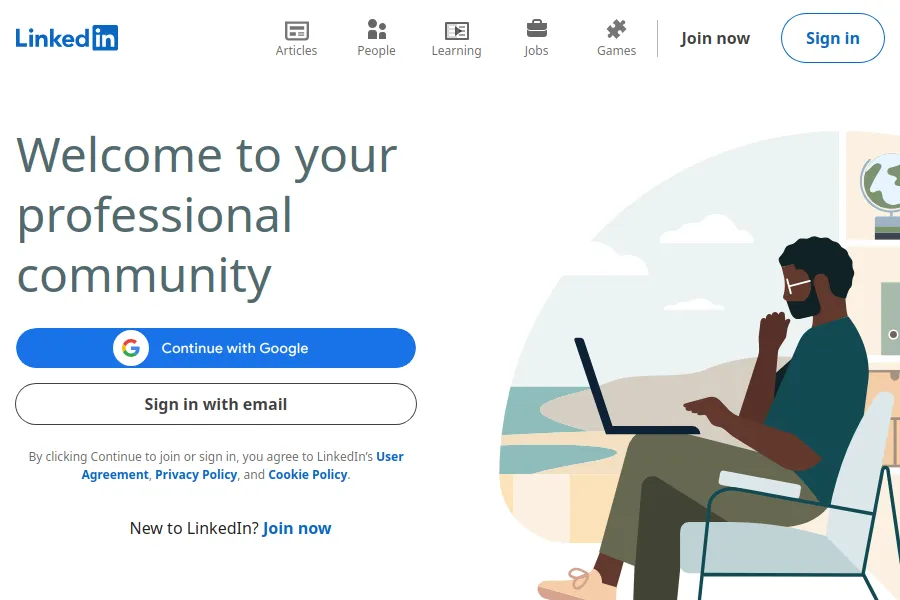
Dice
Specialized in tech roles, perfect for finding CIOs with strong technical backgrounds. Offers targeted search options for specific tech skills.
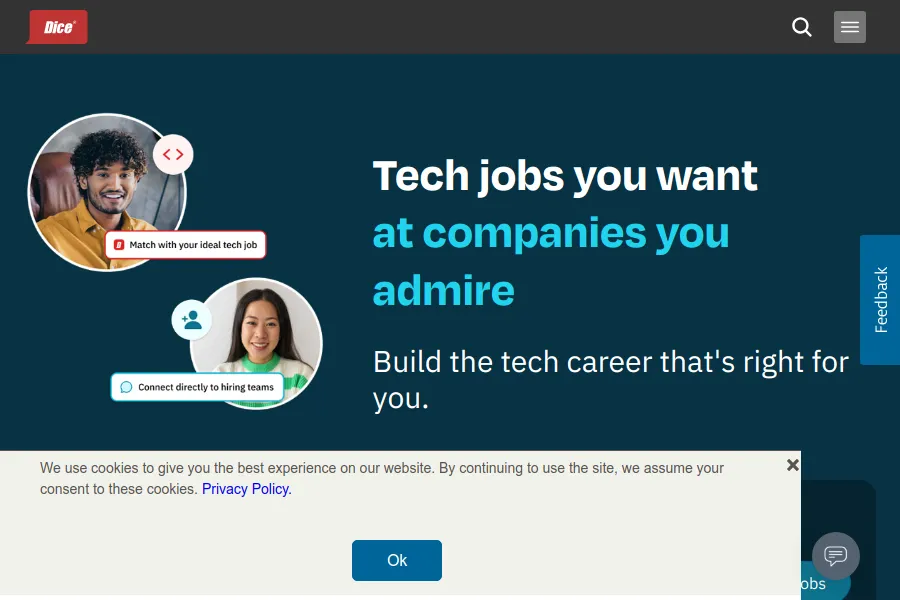
Indeed
Wide-reaching job board suitable for various CIO positions. Offers options for sponsored listings to increase visibility.
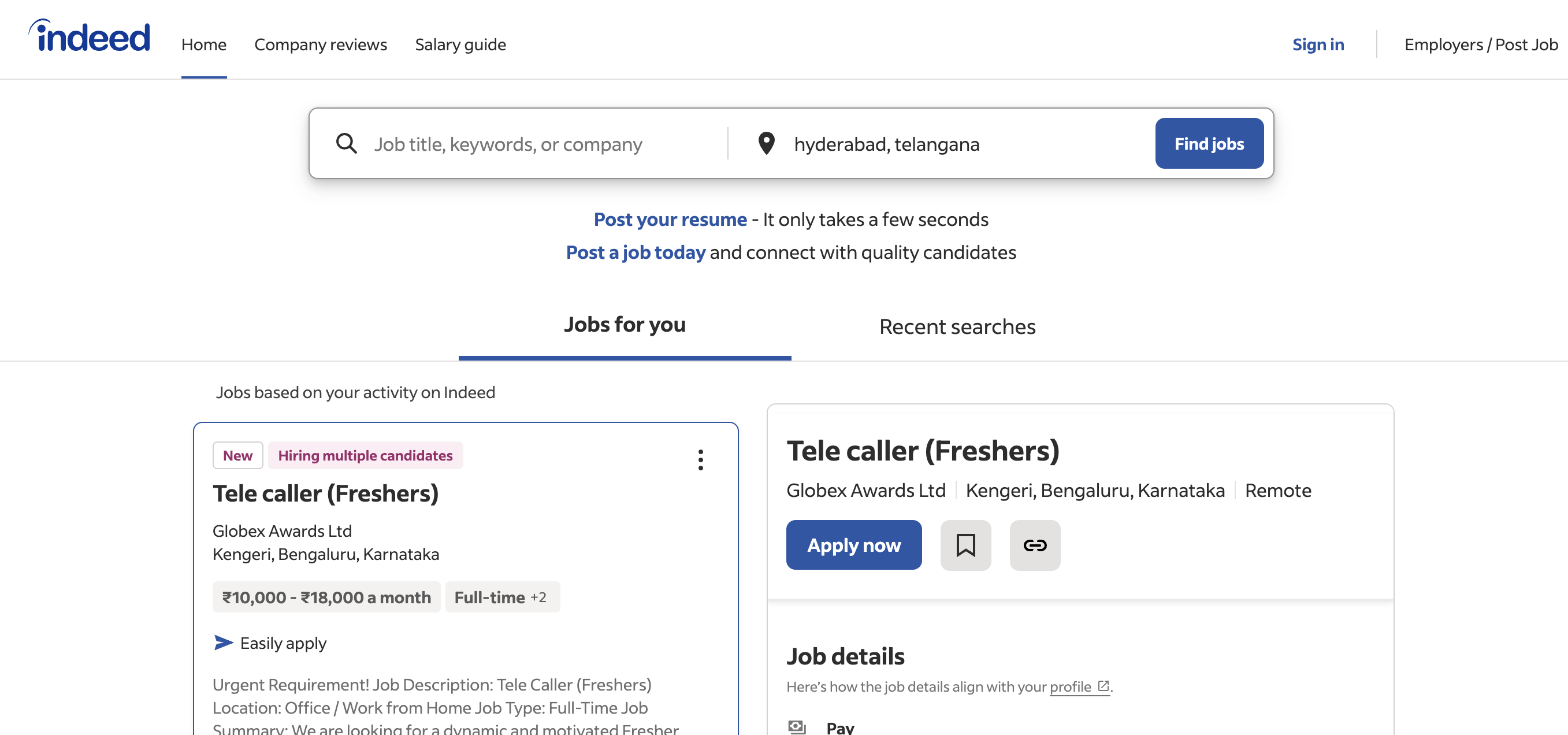
Consider starting with platforms like LinkedIn Jobs, which provides vast professional networking opportunities, or Dice, focusing specifically on tech roles that require strong technical skills. Additionally, Indeed offers a broad reach for varied CIO positions, making it a great starting point for your hiring process. For more specialized needs, explore options like CIO.com Careers, Robert Half for executive searches, and FlexJobs for remote opportunities.
How to screen Chief Information Officer resumes?
Resume screening is a necessary step in the hiring process to filter out candidates who don't meet the basic requirements for a Chief Information Officer (CIO) position. It saves time by allowing recruiters to focus only on candidates with the right skills and qualifications.
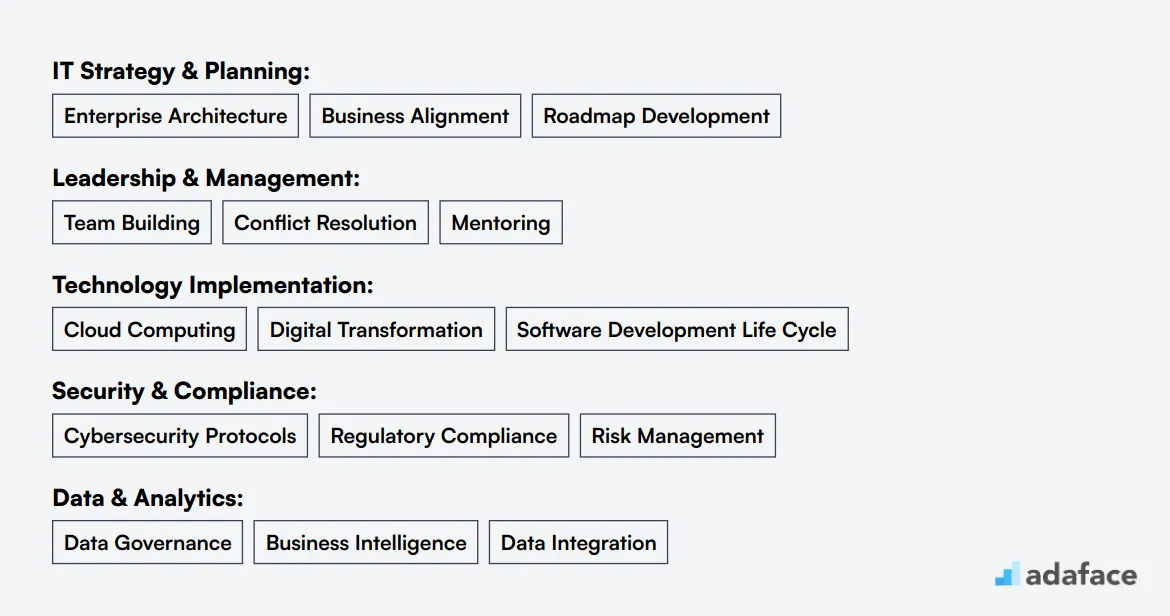
When manually screening resumes, it's important to look for both required and preferred keywords. For a CIO role, examples of primary keywords include "IT strategy," "data analysis," and "leadership," while secondary keywords might be "cloud computing," "cybersecurity," and "change management." Quickly scan for these terms to determine whether a resume is worth further consideration.
Consider using AI tools, like ChatGPT, for more streamlined resume screening. These tools can assist in identifying resumes that align well with job descriptions by highlighting relevant keywords. This process can help reduce bias and ensure a fair evaluation based on skills and experience.
Here's a sample prompt you can use with AI tools to screen resumes for a CIO role:
TASK: Screen resumes to match job description for Chief Information Officer role
INPUT: Resumes
OUTPUT: For each resume, provide the following information:
- Email id
- Name
- Matching keywords
- Score (out of 10 based on keywords matched)
- Recommendation (detailed recommendation of whether to shortlist this candidate or not)
- Shortlist (Yes, No, or Maybe)
RULES:
- If unsure about a candidate's fit, put the candidate as Maybe instead of No
- Keep recommendations concise.
KEYWORDS DATA:
- IT Strategy & Planning (Enterprise Architecture, Business Alignment)
- Leadership & Management (Team Building, Mentoring)
- Technology Implementation (Cloud Computing, Software Development Life Cycle)
- Security & Compliance (Cybersecurity Protocols, Regulatory Compliance)
- Data & Analytics (Data Governance, Business Intelligence)
Recommended skills tests to screen Chief Information Officers
When hiring a Chief Information Officer (CIO), it's important to thoroughly evaluate their skills to ensure they're capable of leading your organization's IT strategy. Skills tests are an effective way to gain insights into a candidate's technical and leadership abilities. Here are some recommended tests to consider:
Business Intelligence Analyst Test: This test evaluates a candidate's ability to transform data into actionable insights. CIOs need to harness business intelligence for strategic decision-making, making this an excellent assessment tool. Business Intelligence Analyst Test
Cloud Computing Online Test: As cloud computing becomes increasingly integral to IT strategies, it's important your CIO understands cloud platforms and services. This test will assess a candidate's knowledge and ability to implement cloud solutions. Cloud Computing Online Test
Cyber Security Test: Protecting organizational data is a top priority for any CIO. This test helps evaluate a candidate's awareness and understanding of cybersecurity principles, crucial for safeguarding your IT infrastructure. Cyber Security Test
ITIL Online Test: Understanding IT service management is key for a CIO. The ITIL test ensures candidates are familiar with best practices for managing IT services, ensuring alignment with business goals. ITIL Online Test
Data Science Test: As data-driven decision-making becomes more common, it's important your CIO can leverage data science. This test assesses a candidate's ability to apply data science in strategic planning. Data Science Test
Case Study Assignments to Evaluate Chief Information Officer Candidates
Case study assignments can be valuable tools for assessing Chief Information Officer (CIO) candidates. However, they come with drawbacks such as lengthy completion times, lower participation rates, and the risk of losing qualified candidates. Despite these challenges, well-designed case studies can provide insights into a candidate's problem-solving skills and strategic thinking.
IT Strategy Overhaul: This case study presents candidates with a fictional company facing technological challenges. Candidates must develop a comprehensive IT strategy, addressing issues like legacy systems, cloud migration, and cybersecurity. This assignment tests the CIO's ability to align IT initiatives with business goals.
Digital Transformation Project: Candidates are tasked with leading a company-wide digital transformation. They must outline a plan for implementing new technologies, managing change, and measuring success. This case study evaluates the CIO's vision for leveraging technology to drive business growth.
IT Budget Optimization: In this scenario, candidates must review an IT department's budget and propose cost-saving measures without compromising service quality. This assignment assesses the CIO's financial acumen and ability to balance resource allocation with operational needs.
What is the Cost of Hiring a Chief Information Officer?
Hiring a Chief Information Officer (CIO) can be a significant investment, with salaries in the U.S. averaging around $172,224 per year. However, this figure can vary widely based on factors like location and experience, with salaries ranging from approximately $90,330 in lower-paying areas to as high as $442,676 in cities like New York. Understanding these figures can help recruiters and hiring managers budget effectively for this key role.
Chief Information Officer Salary in the United States
The average salary for a Chief Information Officer (CIO) in the United States is approximately $172,224. Salaries can vary significantly based on location, with the highest reported salaries reaching up to $442,676 in places like New York and around $331,596 in Los Angeles. On the lower end, CIOs in areas such as Columbus, OH, can earn around $90,330.

Chief Information Officer Salary in the United Kingdom
The average salary for a Chief Information Officer (CIO) in the United Kingdom is approximately £125,000 per year. Salaries can vary based on the size and sector of the company, with lower ranges starting around £80,000 and top earners making up to £200,000 or more. It's essential to consider factors like experience and specific industry when setting a competitive salary.
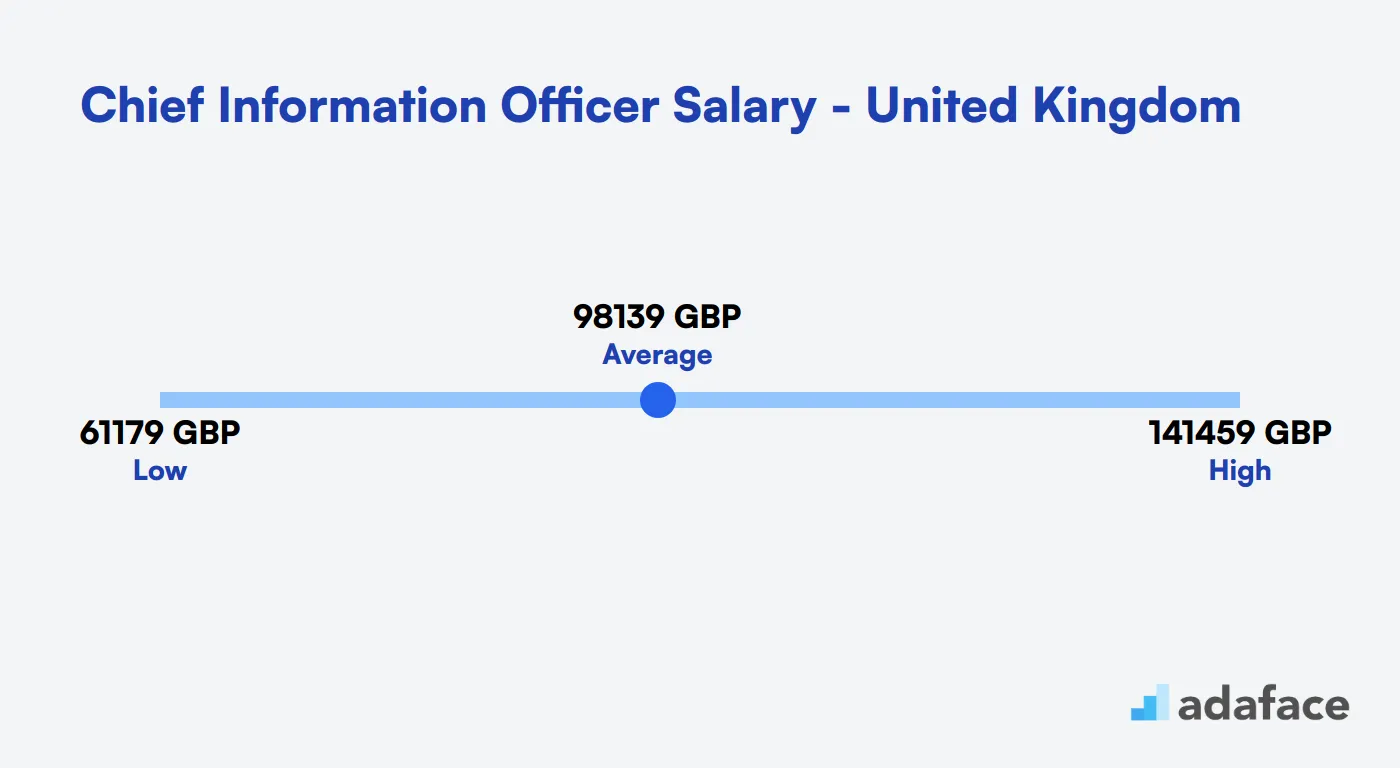
Chief Information Officer Salary in Canada
The average salary for a Chief Information Officer (CIO) in Canada ranges from CAD 75,575 to CAD 192,749, with a median of CAD 120,694. These figures vary based on factors such as location, company size, and industry.
Among major cities, Hamilton, ON offers the highest median CIO salary at CAD 181,844, while Winnipeg, MB has the lowest at CAD 75,460. Toronto, a major tech hub, falls in the middle with a median of CAD 105,692.
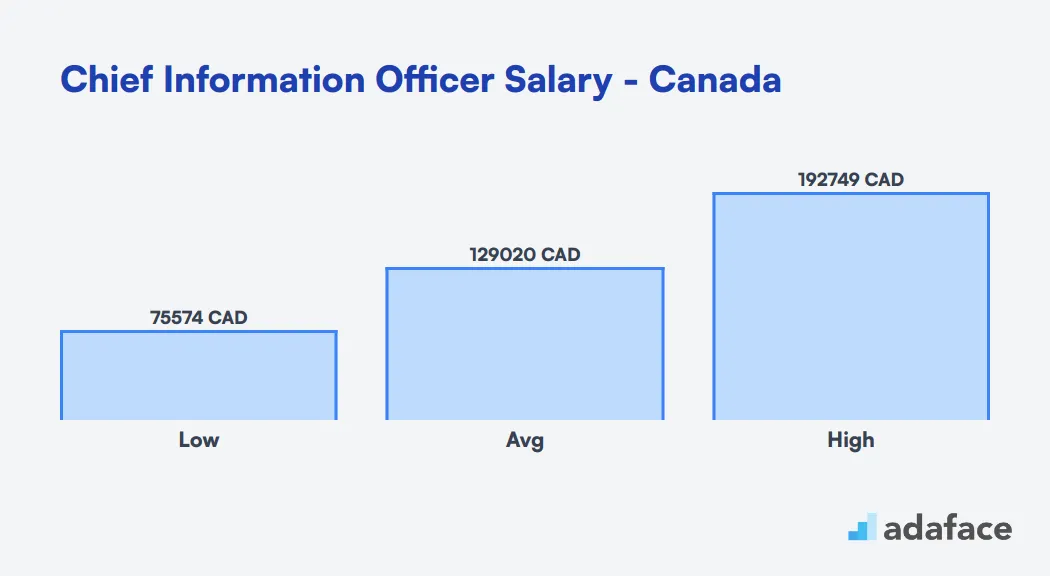
What's the difference between a Chief Information Officer and a Chief Technology Officer?
Though often confused, the roles of Chief Information Officer (CIO) and Chief Technology Officer (CTO) serve distinct functions within an organization. Both positions are integral to a company's technology strategy, but their focus and responsibilities differ significantly.
The CIO primarily focuses on information management and security. They are responsible for overseeing IT systems and infrastructure, ensuring that technology aligns with business goals. In contrast, the CTO is centered around technology development and strategy, concentrating on product innovation and emerging technologies. This difference extends to their core responsibilities, as CIOs manage IT investments and cybersecurity, while CTOs drive technological advancements and product development.
Key distinctions include their strategic roles, with CIOs aligning IT with the business's objectives and CTOs implementing technology to foster growth. Additionally, their reporting structures differ; CIOs typically report to the CEO or COO, while CTOs may report to the CEO or the Board. Understanding these differences can streamline the hiring process and help organizations find the right fit for their leadership needs.
| Chief Information Officer | Chief Technology Officer | |
|---|---|---|
| Primary Focus | Information management and security | Technology development and strategy |
| Core Responsibility | IT systems and infrastructure | Product development and innovation |
| Strategic Role | Align IT with business goals | Implement technology to drive growth |
| Key Skills | Project management, IT governance | Technical design, R&D |
| Reporting Structure | Reports to CEO or COO | Reports to CEO or Board |
| Interaction | Works closely with HR and finance | Collaborates with R&D and marketing |
| Typical Background | IT management, Business administration | Software engineering, Product management |
| Decision Making | Oversees IT investment and cybersecurity | Focuses on tech innovation and architecture |
What are the ranks of Chief Information Officers?
Chief Information Officers (CIOs) play a critical role in shaping an organization's technology strategy. However, the exact title and responsibilities can vary depending on the company size and structure. Let's explore the common ranks within the CIO hierarchy.
- Chief Information Officer (CIO): This is the top-level position responsible for overseeing all IT operations and strategy. The CIO typically reports directly to the CEO and is part of the executive leadership team.
- Deputy CIO: Often found in larger organizations, the Deputy CIO assists the CIO in managing IT operations and may focus on specific areas like infrastructure or application development.
- Senior Vice President of IT: This role is sometimes used interchangeably with CIO, especially in companies where IT is a major focus. They may have broader responsibilities beyond traditional IT functions.
- Vice President of IT: Typically reports to the CIO and manages specific IT domains such as security, infrastructure, or enterprise applications.
- IT Director: Responsible for day-to-day IT operations, the IT Director often oversees a team of IT managers and reports to the CIO or VP of IT.
- IT Manager: Focuses on specific IT functions or departments, such as network operations, help desk, or software development.
Understanding these ranks can help in tailoring your recruitment strategy for the right level of IT leadership. Remember that titles may vary, so it's essential to focus on responsibilities and required skills when hiring.
Business Intelligence Analyst Test
FAQs
A Chief Information Officer (CIO) is responsible for overseeing an organization's IT strategy and ensuring that technology resources align with business goals. They manage the IT department, lead digital transformation initiatives, and work closely with other executives to drive strategic growth.
Key skills for a CIO include strategic thinking, leadership, communication, project management, and technical expertise in IT systems and infrastructure. A successful CIO must also be adept at change management and have a deep understanding of emerging technologies.
An effective CIO job description should include a clear list of responsibilities, required qualifications, and preferred skills. Highlight the strategic importance of the role and the impact the CIO is expected to have on the organization. For a detailed template, visit our CIO job description page.
Top platforms for hiring a CIO include LinkedIn, executive search firms, specialized IT recruitment agencies, and online job boards that focus on executive and leadership roles.
Screen CIO resumes by looking for relevant experience in IT leadership roles, evidence of strategic impact on previous organizations, and alignment with your company’s goals. Consider using competency-based assessments to evaluate their skills further.
Recommended skills tests for CIO candidates include assessments on technology strategy, IT governance, cybersecurity, and leadership abilities. Visit our skills assessment tools page for more information.
Case study assignments allow candidates to demonstrate their strategic thinking, problem-solving abilities, and how they would handle real-world challenges. They provide insights into a candidate’s approach to digital transformation and IT management.

40 min skill tests.
No trick questions.
Accurate shortlisting.
We make it easy for you to find the best candidates in your pipeline with a 40 min skills test.
Try for freeRelated posts
Free resources



